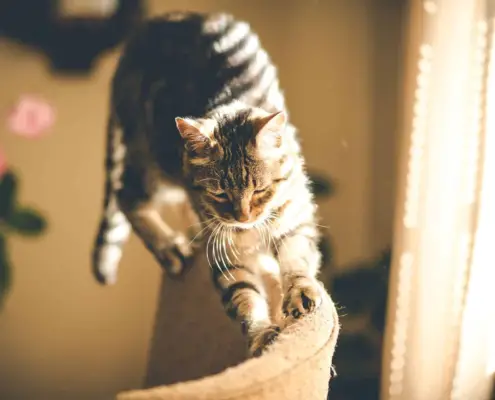
When it comes to the world of feline pigmentation, there is much more than meets the eye. The coloration of a cat’s fur is determined by a complex interplay of genetics, hormones, and environmental factors. The science behind feline pigmentation is a fascinating subject that has intrigued scientists and cat lovers alike for centuries.
At the core of feline pigmentation is the presence of melanocytes, specialized cells responsible for producing the pigment melanin. Melanin comes in two forms: eumelanin, which produces black and brown colors, and pheomelanin, responsible for red and yellow hues. The amount and distribution of these pigments in a cat’s fur determine its color and pattern.
Do cats really change color?
It is a common belief that cats can change color over time. While this may seem like a magical transformation, the truth is that cats do not change their actual pigmentation once they reach adulthood. However, there are instances where a cat’s color may appear to change due to various factors.
One such factor is the phenomenon known as “sun bleaching.” When a cat spends a significant amount of time in the sun, the ultraviolet rays can cause the fur to lighten or fade. This is particularly noticeable in cats with dark fur, as the contrast between the original color and the sun-bleached areas becomes more apparent.
Another reason for the perceived color change is the shedding of fur. As cats shed their old fur and grow new fur, the texture and appearance of their coat may change. This can give the impression of a color change, especially if the new fur has a different shade or pattern than the old fur.
Factors that can affect a cat’s color
While cats may not change their pigmentation, there are several factors that can influence the appearance of their fur. One such factor is age. Just like humans, cats’ fur can change as they age. Kittens often have a different coat color and pattern than their adult counterparts. As they mature, their fur may darken or develop new markings.
Hormonal changes can also play a role in a cat’s coloration. Female cats, for example, may experience color changes during pregnancy or after giving birth. The fluctuation in hormones can cause the fur to appear lighter or darker.
Additionally, certain health conditions can affect a cat’s color. For instance, some cats with thyroid issues may develop a condition called hyperpigmentation, where the fur becomes darker than usual. Similarly, cats with liver or kidney problems may experience changes in their pigmentation due to the body’s inability to process toxins properly.
The role of genetics in feline pigmentation
Genetics plays a significant role in determining a cat’s color and pattern. The genes responsible for feline pigmentation are complex and can interact in various ways, resulting in a wide range of colors and patterns.
One of the key genes involved in feline pigmentation is the melanocortin-1 receptor gene (MC1R). This gene controls the production of eumelanin and pheomelanin, determining whether a cat will have black or red-based fur.
Other genes, such as the agouti signaling protein gene (ASIP) and the KIT gene, influence the distribution and pattern of pigmentation. Variations in these genes can lead to unique coat patterns, such as tabby or tortoiseshell.
Understanding the genetic basis of feline pigmentation not only helps researchers unravel the mysteries of cat coloration but also has practical applications in breeding programs and genetic testing for inherited conditions.
Common misconceptions about cat color changes
There are several common misconceptions about cat color changes that need to be addressed. One of the most prevalent misconceptions is that cats can change their fur color based on their mood. While it is true that a cat’s mood can affect its behavior and body language, it does not have any direct impact on its pigmentation.
Another misconception is that cats can change their color to blend in with their surroundings, similar to a chameleon. While cats are known for their agility and ability to camouflage, their fur color remains the same regardless of their environment.
It is important to dispel these misconceptions to ensure accurate information is shared about feline pigmentation.
Examples of cat breeds with unique color-changing abilities
While most cats do not change their pigmentation, there are some cat breeds that exhibit unique color-changing abilities. One such breed is the Siamese cat. Siamese cats are born with white fur, which gradually darkens as they age. This change is due to a temperature-sensitive gene that causes the fur to darken in cooler areas of the body.
Another example is the Tonkinese cat, a breed that can display a variety of coat colors and patterns. The coat color of a Tonkinese cat can change depending on its temperature, similar to the Siamese cat. This unique trait adds to the allure of these fascinating felines.
How to care for a cat with changing pigmentation
If you have a cat with changing pigmentation, it is essential to provide proper care to ensure their overall well-being. Regular grooming is crucial to maintain a healthy coat. Brushing your cat’s fur helps remove dead hair and prevents matting, ensuring a vibrant and even appearance.
Additionally, providing a balanced and nutritious diet is essential for maintaining healthy skin and fur. Consult with your veterinarian to determine the most suitable diet for your cat’s specific needs.
Lastly, monitor your cat’s exposure to sunlight, especially if they have dark fur. While some sun exposure is beneficial for cats, excessive ultraviolet rays can lead to sunburn and color fading. Consider providing shaded areas or using pet-safe sunscreen to protect your cat’s skin.
The future of research on feline pigmentation
The study of feline pigmentation is an ongoing area of research, with scientists continually uncovering new insights into the genetics and mechanisms behind cat coloration. As technology advances, researchers are now able to sequence the entire feline genome, providing a deeper understanding of the genes responsible for pigmentation.
This knowledge has the potential to revolutionize the field of cat breeding, allowing breeders to selectively produce specific coat colors and patterns. It also opens the door to further exploration of the genetic basis of other traits, such as eye color and behavior.
Fascinating stories of cats with color-changing abilities
Throughout history, there have been numerous fascinating stories of cats with color-changing abilities. One such story involves the Turkish Van cat, a breed known for its unique coat pattern and color-changing capabilities. According to legend, Turkish Van cats were once all white, but as they swam across the Lake Van in Turkey, their fur absorbed the color of the water, resulting in the distinct markings seen today.
Another captivating tale involves the Maine Coon, a breed with a wide range of coat colors and patterns. It is believed that the Maine Coon’s color-changing abilities allowed it to blend in with its surroundings, providing a natural advantage in hunting and survival.
The magic and mystery of cat color changes
In conclusion, while cats do not truly change their pigmentation, the world of feline coloration is a captivating and complex subject. Understanding the science, genetics, and factors that influence a cat’s color can deepen our appreciation for these remarkable creatures.
By dispelling common misconceptions and exploring the unique color-changing abilities of certain breeds, we can develop a greater understanding of the magic and mystery of cat color changes. Whether it’s the gradual darkening of a Siamese cat’s fur or the chameleon-like qualities of a Tonkinese cat, the allure of feline pigmentation continues to captivate and fascinate cat lovers worldwide.
So the next time you admire your cat’s coat, remember the intricate science behind their pigmentation and the beauty it brings to their feline form.
If you enjoyed my article, I would appreciate you sharing it with your network.

Sima Ndlebe
Sima writes for CatBuzz. He is interested in Cats, Health and Fitness, and Entrepreneurship.
Published: 12 December 2023



